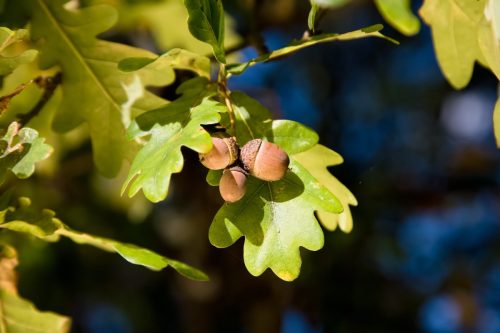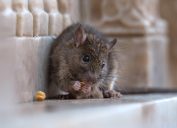6 Plants in Your Yard That Are Inviting Pests to Your Home
Find out which trees, shrubs, and flowers are welcoming insects and rodents indoors.

Spring has just about sprung, and that means our favorite seasonal blossoms have arrived—or will be arriving soon. Gardeners and garden lovers alike can appreciate a lush space, and for those of us who take pride in our yards, now is the time to really show off. But having a variety of flowers and trees is not without its downsides, as some of your favorites might actually be inviting pests into your home. Read on to find out which plants could be rolling out the welcome mat for creepy critters and crawlers.
READ THIS NEXT: If You Notice This in Your Yard, Watch Out for Venomous Spiders.
1
Fruit trees

This one may seem like it goes without saying, but fruit trees are the most common culprit when it comes to inviting pests into your home. "Unfortunately, any fruit-producing tree is going to attract insects, as well as mice—if fruits fall to the ground," Jeremy Yamaguchi, CEO of Lawn Love, says.
While you may not have to worry so much about bugs in this instance, when fruit falls to the ground without being picked up immediately, mice are likely to find their way indoors.
If you simply love looking out your window at a flowering apple tree, Yamaguchi recommends strategic planting. "The best way to have fruit trees and keep mice out of your home is to plant trees far away from your house," he says. "And make sure you are taking care of your trees consistently and not allowing fruits to fall and decompose."
2
Tuberous vegetables

If veggies like carrots, potatoes, or turnips are staples in your garden, they could also be welcoming pests. These tuberous vegetables grow in the ground, but those that grow above ground—like cabbages, leeks, tomatoes, and peas—could also attract different rodents to your property, according to Carol's Colors Landscaping. You can keep these pests at bay, and away from your home, by planting herbs that naturally repel insects alongside the attractive vegetables. These include basil, lemon thyme, oregano, parsley, and rosemary.
READ THIS NEXT: Growing This in Your Yard Is Inviting Snakes to Your Home.
3
Pine trees

Pine trees may not be the first tree to come to mind when you think about pests entering your home, but while not all pine trees are bug magnets, the smell of their sweet sap can attract mosquitoes and other biting insects, according to Contractor's Best Pest Solution. In warmer weather, these creepy crawlers may stay put in their treehouse, but when the weather gets cold, they can migrate to your home instead, Ronnie Collins, MS, founder of the Electro Garden Tools blog, points out. You should also heed this warning during the holiday season when bringing a pine Christmas tree inside, as these are known to be a haven for spiders.
4
Peonies

Peonies are the perfect addition to a floral landscape. These full, fluffy, and fragrant flowers are the favorite of many—including insects. Peonies are often seen adorned with ants, and it was long believed that these flowers require ants to help them bloom. That myth was dispelled by the University of Missouri, as peonies do in fact attract ants with their tasty sap, but the ants aren't needed for blooming purposes. However, ants do protect the flowers from other insects that may feed on them, creating a mutually beneficial relationship.
If you are pruning your peony bush for an indoor arrangement, you'll want to check the petals for any stowaways first. According to House Beautiful, you can run the buds under warm tap water to remove ants, and rest assured, once peony buds fully open and flower, the ants will have moved on.
For more helpful home advice sent straight to your inbox, sign up for our daily newsletter.
5
Cottonwood trees

Cottonwood trees are certainly a sight to see, but as much as you enjoy looking at the vibrant green foliage of these shade trees, their blooms also play host to aphids, flies, mosquitoes, and several other insects, according to Quality Tree Service. According to Charlotte Bailey, former horticulturist and founder of Oh So Garden, the sap from these trees attracts wasps and hornets, and you could unknowingly invite them inside your house if you have a cottonwood planted nearby.
6
Oak trees

Oak trees could be the cause of a mouse infestation, but not for the reason you might expect. The real problem is with the oaknut, more commonly referred to as the acorn. According to Arrow Exterminating Company, acorns are a food source for mice, and they may take up residency in your house when looking for a safe place to hide their next meal from predators. You may not want to cut down that aging oak, but you can take preventative steps to keep mice—and the deer ticks they could be carrying—at bay. Do this by cleaning up any acorns around your yard, horticulturist Stuart Mackenzie of Trees.com advises.
READ THIS NEXT: You're Inviting Mice to Your Home If You Have This in Your Yard.





















